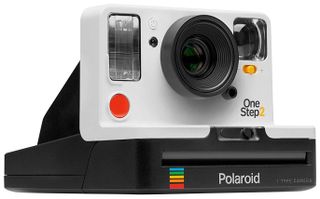Polaroid Pop vs Polaroid OneStep 2: Which should you buy?


Go big or go home
Polaroid Pop is where modern meets retro. It does well as a digital camera with adjustable lighting modes thanks to the 20MP sensor, has 1080p HD video recording capabilities, and can even make GIFS, with the ability to save everything onto a microSD card. You can be selective about what gets printed so that expensive ZINK paper isn't wasted, but be wary of the somewhat low resolution of non-sticker prints.
For
- 20MP sensor, 1080p HD video
- Large, easy-to-use touchscreen
- Supports microSD cards up to 128GB
- Manually choose lighting situation
- Rechargeable lithium-ion battery lasts up to 50 prints
Against
- Fairly large size
- Low-resolution print quality
- Slow printing speed
- ZINK paper does not have a sticker option

Kick it old school
The Polaroid OneStep 2 is a modern-day replica of a tried-and-true classic. If you're going for unlimited possibilities of perfect imperfection that only Polaroid can achieve, then OneStep 2 is great. It works right out of the box, and it works with any film as long as it's i-Type or 600, leaving you room to get creative. However, you won't be able to keep digital copies of anything, and the film itself is fairly expensive.
For
- Completely retro inspired
- Works right out of the box
- Compatible with all styles of i-Type and 600 Film
- Has 106mm lens and flash that can be manually controlled
- Charges via Micro-USB, lasts up to 60 days
Against
- No digital copies
- No video recording
- Expensive film
- No manual control of photos
While both of these cameras come from Polaroid, they're aimed for two different groups of people. If you want to try your hand at the old style Polaroids like your grandparents, then the OneStep 2 is the way to go. If you prefer to have a Polaroid with modern capabilities, then you should try the Pop.
Let's break it down
Depending on what you're looking for in an instant camera, both the Polaroid Pop and OneStep 2 are good choices in their respective categories.
| Header Cell - Column 0 | Polaroid Pop | Polaroid OneStep 2 |
|---|---|---|
| Price | $200 | $100 |
| Dimensions | 6 x 4 x 1 in | 6.7 x 4.72 x 4.72 in |
| Design | Bulky, thick, rounded square | Original Polaroid OneStep |
| Battery | Lithium-ion up to 50 prints | Rechargeable via Micro-USB, lasts 60 days |
| Megapixels or lens | 20MP | 106mm lens |
| Video recording | 1080p HD | None |
| Digital copies | Yes with microSD up to 128GB | No |
| Film | 3.5x4.25" inch ZINK paper | i-Type or 600 Film |
| Bluetooth | No | No |
| Wi-Fi | Yes | No |
| Compatible app | Yes | No |
| Manual lighting adjustments | Yes | No |
| Flash | Yes | Yes |
| Self-timer | Yes | Yes |
With the Polaroid Pop, you're getting a 20MP digital camera that's able to record HD video in either 1080p or 720p, which is more than a lot of instant cameras can do. The large touchscreen on the Pop allows you to easily see what the viewfinder sees, so you can frame your photos accordingly. Once a photo is taken, you can edit it right on the touchscreen with any necessary adjustments, or you can add fun touches like stickers, frames, and other effects before choosing to print it out.
If you download the companion Polaroid Pop app, you can connect to your smartphone via Wi-Fi and send pictures from your Camera Roll into the Pop itself. From there, you can edit the photos and print them out, as you would with a standalone photo printer.
The video recording capability of the Polaroid Pop is also impressive. With just a tap, you can record gorgeous video in 1080p HD resolution, and even turn short 15-second videos into animated GIFs, right on the camera itself.
Both the Polaroid Pop and OneStep 2 are good for their respective audiences.
The OneStep 2 is a throwback design. It was modeled off the original Polaroid OneStep, which was released in the 1970s. This new edition is designed for those who want to replicate the traditional Polaroid OneStep instant camera feeling. The shape of the camera itself won't make carrying it very easy, but it does work right out of the box as long as you have some i-Type or 600 film ready. However, the film isn't exactly cheap (average price of $16 or $19 with about eight sheets) and the camera doesn't come with any. You're going to need to spend extra on paper no matter what camera you purchase, but compared to the ZINK paper that the Pop uses, it's even more expensive.
With the OneStep 2, it's important to also remember that you won't have too much control over the results. The camera is designed to automatically adjust how much light gets in, so you can't manually adjust it. However, the OneStep 2 does have a flash suppression button that you can push down while taking a picture if you choose to not have flash (it goes off for every picture otherwise).
Master your iPhone in minutes
iMore offers spot-on advice and guidance from our team of experts, with decades of Apple device experience to lean on. Learn more with iMore!
You also don't get support for microSD cards at all with the OneStep 2, so there are no digital copies, just purely analog prints. And of course, there's no video recording either, just like with the original.
Both the Polaroid Pop and OneStep 2 are good for their respective audiences. However, if we must go with one here, we'd recommend the Polaroid Pop over the OneStep 2. It just offers a lot more, and even though it has a high sticker price at first, the 3.5-by-4.25-inch ZINK paper it uses ends up being a lot cheaper in the long run compared to the i-Type or 600 film you need for the OneStep 2. But if you really want to try an analog instant camera and get those cool, imperfect shots, then by all means, give the OneStep 2 a try. The price point for the camera itself isn't too high, at least.

Retro meets modern
Polaroid Pop is a fun digital instant camera that lets you be selective about what gets printed, and it can record 1080p HD video and make animated GIFs. You can connect it to your smartphone via Wi-Fi and app to print smartphone photos too. The Pop supports microSD cards up to 128GB in size and prints on ZINK paper.

Perfect imperfection
The Polaroid OneStep 2 is a modern replica of an original instant camera. It works with any i-Type or 600 film you have, and uses ambient light sensors and flash to create a truly analog experience. It may appear affordable, but be warned — the film it uses can be pricey.
Christine Romero-Chan was formerly a Senior Editor for iMore. She has been writing about technology, specifically Apple, for over a decade at a variety of websites. She is currently part of the Digital Trends team, and has been using Apple’s smartphone since the original iPhone back in 2007. While her main speciality is the iPhone, she also covers Apple Watch, iPad, and Mac when needed.
When she isn’t writing about Apple, Christine can often be found at Disneyland in Anaheim, California, as she is a passholder and obsessed with all things Disney, especially Star Wars. Christine also enjoys coffee, food, photography, mechanical keyboards, and spending as much time with her new daughter as possible.
Most Popular




